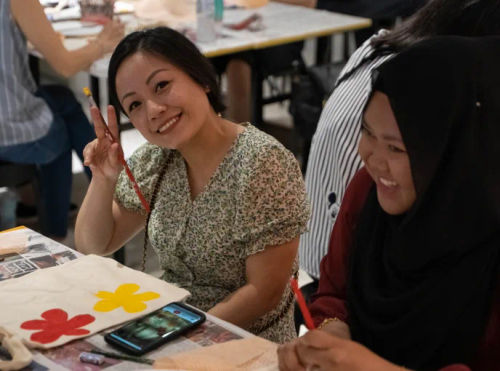Team Bonding Games Students Singapore

Team bonding games play a vital role in the personal and academic development of students. By fostering teamwork, communication, and collaboration, these games create an environment where students can connect, build relationships, and enhance their social skills.
In Singapore, the popularity of team bonding games has been on the rise, with educators and school administrators recognizing their positive impact on student engagement and overall well-being. In this article, we present a carefully curated list of the top team bonding games suitable for students in Singapore in 2023. These games are designed to provide fun, interactive experiences that promote teamwork and leave a lasting impact on the participants.
Understanding Team Bonding for Students
Team bonding refers to the process of bringing individuals together to form a cohesive and collaborative group. For students, team bonding activities are crucial in developing crucial skills such as effective communication, problem-solving, and leadership. By engaging in team bonding games, students learn to work together, respect diverse perspectives, and leverage the strengths of entire team member. These activities also create a positive and inclusive learning environment where students feel supported and motivated to contribute their best. The interactive nature of team bonding games ensures that students actively participate, leading to improved social interactions and a sense of belonging within the group.
Key Consideration Factors for Selecting Team Bonding Games
When selecting team bonding games for students, consider the following key factors:
- Age Appropriateness: When selecting team bonding games, it is important to consider the age group of the students. Choose games that are suitable for their developmental stage, taking into account their physical abilities, attention span, and interests. By selecting age-appropriate games, you ensure that the activities are engaging and enjoyable for the students.
- Group Size: The number of participants in the team bonding activities is a crucial factor to consider. Select games that can accommodate the specific group size. This ensures that all students can actively participate and have opportunities for interaction and collaboration. Games that work well with smaller groups may not be suitable for larger groups, so choosing games that fit the group size helps maintain engagement and effective teamwork.
- Accessibility and Inclusivity: Inclusivity is key when selecting team bonding games. Choose games that are accessible and inclusive for all students, regardless of their abilities or limitations. Make necessary adaptations or modifications to ensure equal participation and engagement. Consider factors such as physical accessibility, communication preferences, and any specific accommodations that may be required. By prioritizing accessibility and inclusivity, you create an environment where all students can fully participate and contribute.
- Learning Objectives: When selecting team bonding games, align them with specific learning objectives. Consider the desired outcomes you want to achieve through the team bonding activities. Focus on developing skills such as communication, problem-solving, leadership, and collaboration. By aligning the games with the desired learning objectives, you ensure that the activities have a purpose and contribute to the overall growth and development of the students.
- Resources and Space: Consider the availability of resources and space when selecting team bonding games. Choose games that require minimal equipment and can be adapted to limited spaces. This ensures that the activities can be easily implemented in various settings, such as classrooms, school halls, or outdoor areas. By selecting games that make efficient use of resources and space, you can effectively organize and conduct the team bonding activities.
- Time Constraints: Time constraints are an important consideration when selecting team bonding games. Assess the available time frame for the activities and choose games that can be completed within that time. Adjust the duration of the games accordingly, whether you need shorter icebreaker activities or longer team-building challenges. By ensuring that the games fit within the given time constraints, you can effectively manage the schedule and make the most of the team bonding experience.
- Safety Considerations: Safety is paramount when organizing team bonding games. Prioritize the safety and well-being of the participants throughout the activities. Conduct risk assessments to identify potential hazards and implement appropriate safety measures. Ensure proper supervision is in place to mitigate any risks. By addressing safety considerations, you create a secure environment that allows students to fully engage in the team bonding activities.
Best Team Bonding Games Students Singapore
1. Art Jamming

Art Jamming is a creative team bonding activity where participants come together to express themselves through art. Students can unleash their creativity and enjoy painting together on individual canvases or collaborative artworks. This fun team building activity promotes collaboration, communication, and artistic exploration. It allows students to bond over shared experiences and showcases their unique perspectives in a fun and relaxed setting.
2. Outdoor Adventure Challenges

Outdoor Adventure Challenges involve a range of thrilling corporate team building activities such as rope courses, obstacle courses, and team-building games set in an outdoor environment. Students get to push their limits, overcome challenges, and work together as a team. This activity promotes trust, problem-solving, and effective communication while fostering a team spirit of adventure and camaraderie among the students.
3. Amazing Race

Modeled after the popular TV show, the Amazing Race team bonding game involves teams competing in a series of challenges and tasks across different locations. Students must navigate through clues, solve puzzles, and complete physical and mental challenges to reach the finish line. This fast-paced and exciting game encourages teamwork, strategy, and time management skills while fostering a sense of healthy competition among the students.
4. Escape Room Challenge

Escape Room Challenge is a thrilling team bonding activity where participants are locked in a room and must work together to solve puzzles, find clues, and escape within a given time frame. This activity requires effective communication, critical thinking, and collaboration. It promotes problem-solving skills and encourages students to think creatively under pressure, fostering a sense of unity and shared achievement.
5. Puzzle and Board Game Night

Puzzle and Board Game Night is a relaxed and interactive team bonding activity where students gather to play various board games and solve puzzles together. This activity encourages strategic thinking, problem-solving, and healthy competition. It provides an opportunity for students to engage in friendly rivalry, enhance their cognitive skills, and build connections through shared experiences and laughter.
6. Team Building Games

Team Building Games encompass a wide range of interactive cool team building activities designed to foster teamwork, trust, and cooperation. These games can include trust falls, blindfolded challenges, and problem-solving activities. They promote effective communication, collaboration, and conflict resolution among students. Through these games, students develop a deeper understanding of each other’s strengths and learn to work together towards a common goal.
7. Cooking Challenge

The Cooking team building activity involves students working together in teams to prepare and cook a meal. This activity promotes cooperation, delegation, and creativity. Students learn to communicate effectively, follow instructions, and work under time constraints. It also encourages students to appreciate different culinary cultures and nurtures their problem-solving skills as they navigate the kitchen together.
8. Sports Tournament

A Sports Tournament brings students together in a competitive sports event, where teams compete in various sports activities such as football, basketball, or volleyball. This fun team bonding activity fosters teamwork, sportsmanship, and physical fitness. Students learn the importance of collaboration, strategy, and healthy competition while enjoying the thrill of sports and building camaraderie on the whole team.
9. Charity or Community Service Projects

Engaging in Charity or Community Service Projects allows students to bond through giving back to the community. This activity can involve volunteering at a local charity, organizing fundraising for your next team building event, or participating in community improvement projects. Students learn empathy, teamwork, and the value of making a positive impact on society. It creates a sense of purpose and instills a lifelong commitment to social responsibility.
10. Improv Games

Improv Games involve spontaneous and unscripted performances where students collaborate to create scenes, stories, and characters on the spot. This activity enhances creativity, adaptability, and teamwork. Students learn to listen actively, think on their feet, and support each other’s ideas. Improv Games encourage students to step out of their comfort zones, embrace creativity, and build strong bonds through shared laughter and creative expression.
Tips for Organizing Team Bonding Games
- Venue Selection: Choose an appropriate venue that can accommodate the team bonding activities and the number of participants. Consider factors such as space, facilities, and safety. Ensure that the venue is suitable for the age group of the students and provides a conducive environment for the activities.
- Equipment Preparation: Prepare the necessary equipment and materials in advance to ensure a smooth execution of the team bonding games. Check that all equipment is in good working condition and readily available when needed. This includes any props, game materials, or safety equipment required for the activities.
- Clear Rules and Guidelines: Establish clear rules and guidelines for the team bonding games. Communicate these rules to the participants beforehand to ensure everyone understands the expectations and boundaries. Emphasize fairness, respect, collaboration, and teamwork. Clear rules and guidelines create a structured and inclusive environment for the activities.
- Positive and Supportive Atmosphere: Foster a positive and supportive atmosphere during the team bonding games. Encourage active participation, open communication, and mutual support among the participants. Create an environment where students feel comfortable taking risks, expressing their ideas, and working together. A positive and supportive atmosphere enhances the overall team bonding experience.
- Communication and Reflection: Promote open communication among the participants during and after the team bonding games. Provide opportunities for students to reflect on their experiences, share insights, and learn from one another. Encourage them to communicate their thoughts, feelings, and ideas related to the activities. This allows for deeper engagement and personal growth.
- Inclusivity: Ensure that the team bonding games cater to the needs and abilities of all participants. Make necessary adaptations or modifications to promote inclusivity. Consider factors such as physical accessibility, communication preferences, and any specific accommodations required. By fostering inclusivity, you create an environment where all students can actively participate and contribute to the team bonding activities.
- Safety Measures: Prioritize the safety and well-being of the participants throughout the team bonding games. Implement safety measures, including proper supervision, first aid provisions, and risk management strategies. Conduct ongoing monitoring to ensure a safe environment for all participants. By prioritizing safety measures, you create a secure and enjoyable experience for everyone involved in the team bonding activities.
Team Bonding Games Students Singapore
Team bonding games have the potential to create a fun and meaningful experience for students in Singapore. From trust falls to cooking challenges, these favourite team building activities provide an opportunity for students to build strong relationships through shared experiences and laughter.
By taking into consideration factors such as venue selection, equipment preparation, safety measures, and inclusivity when organizing team bonding games, you can ensure that every participant feels included and has an enjoyable time. Through collaborative problem-solving tasks or competitive sports tournaments, students learn valuable lessons about teamwork while having a blast!
Frequently Asked Questions (FAQs)
If you have any questions about team bonding games for students in Singapore, you can refer to the frequently asked questions (FAQs) about the best Team Bonding Games for Students in Singapore below:
What is the purpose of team bonding activities for students?
Team bonding activities for students serve multiple purposes. They promote teamwork, communication, and collaboration among students, helping them develop crucial social and interpersonal skills. These activities also create a positive and inclusive learning environment, fostering a sense of belonging and enhancing overall student well-being.
How do team bonding games benefit academic performance?
Team bonding games have a positive impact on academic performance. By promoting skills such as problem-solving, communication, and collaboration, these games enhance critical thinking abilities and encourage students to work together to find solutions. Additionally, team bonding activities create a supportive learning environment, leading to increased student engagement and motivation, which can positively influence academic achievement.
What are some examples of team bonding games suitable for different age groups?
For primary school students, games like “Musical Chairs” or “Simon Says” can be engaging. In secondary schools, activities such as “Escape Room Challenge” or “Amazing Race” are popular choices. For older students or university-level participants, more complex team building games like “Minefield” or “Bridge Building” can be suitable.
How can team bonding games be integrated into the school curriculum?
Team bonding games can be integrated into the school curriculum by aligning them with specific learning objectives. Educators can incorporate these activities during physical education classes, student leadership programs, or even as part of subject-specific projects. By linking the games to the curriculum, students can apply their knowledge in a practical and collaborative setting.
Are team bonding games inclusive for students with disabilities?
Yes, team bonding games can be made inclusive for students with disabilities. Educators and organizers should consider making adaptations or modifications to ensure that all participants can actively engage in the activities. This may involve providing alternative methods of participation or adjusting the rules to accommodate different abilities.
How can team bonding games be conducted safely?
To ensure the safety of participants during team bonding games, it is important to conduct a risk assessment prior to the activity. Proper supervision should be provided, and safety measures should be in place. This includes having a first aid kit on hand, addressing any potential hazards, and implementing appropriate precautions based on the specific activities being undertaken.
Are team bonding games effective for virtual or remote learning environments?
Yes, team bonding games can be adapted for virtual or remote learning environments. Virtual team building activities like online escape rooms, virtual scavenger hunts, or collaborative virtual art projects can foster teamwork and engagement among students, even when they are physically apart.
Where can I find additional resources for team bonding game ideas?
There are various resources available for team bonding game ideas. Online platforms, educational websites, and team building event companies often provide a wide range of game suggestions and guidelines. Additionally, networking with other educators and sharing ideas within professional communities can offer valuable insights and inspiration.
How can team bonding activities benefit student well-being and mental health?
Engaging in team bonding activities positively impacts student well-being and mental health. These activities provide an outlet for students to connect with their peers, reduce stress, and build supportive relationships. The sense of belonging and camaraderie developed through team bonding games contributes to overall emotional well-being and creates a positive school environment.
